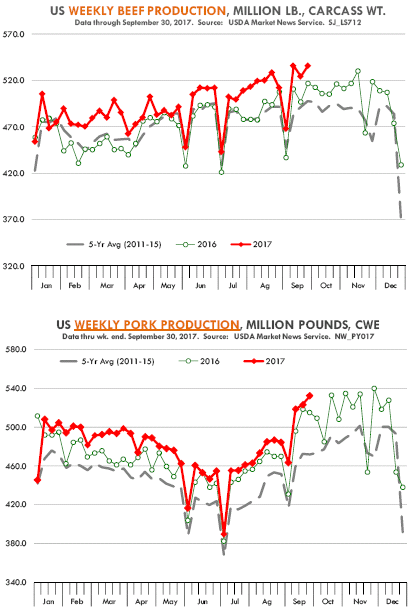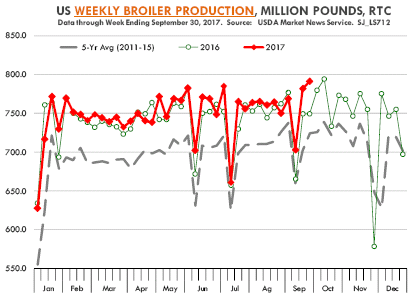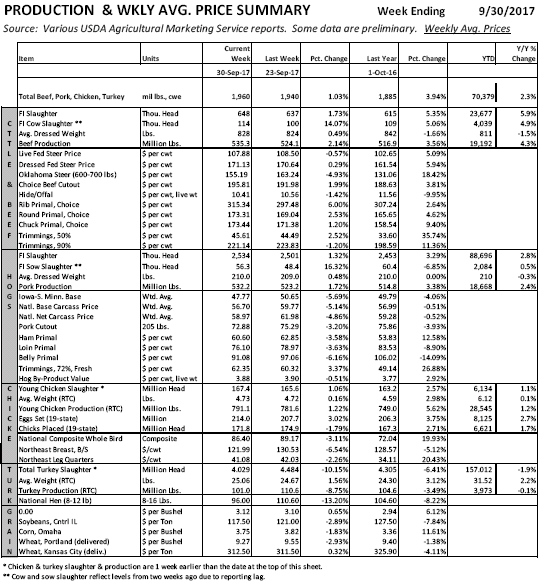



CME: Lean Hog Futures Shrug Off Bearish Implications
US - Lean hog futures on Friday seemed to shrug off some of the bearish implications from the latest "Hogs and Pigs" report, writes Steiner Consulting Group, DLR Division, Inc.While the October contract is firmly anchored by current cash prices, the December contract gained 167 points and February was up 170 points. Some of the increase in futures may be due to optimism that the decline in hog/pork prices will encourage more retail ads later in the year and also push more pork into export markets.
The USDA weekly pork export sales report released on Thursday showed that for week ending 21 September net pork sales were 36,658 MT, a big jump considering that weekly exports have been running at around 20,000 MT in recent weeks. US pork prices hold a significant advantage relative to EU pork prices, which should bolster shipments into Asian markets.
The weekly export sales report were also confirmed by data from Mandatory Price Report, which tracks pork sold into overseas markets (NAFTA sales are not included). According to the MPR data, which is through 22 September, overseas pork export sales in the last two weeks have averaged 31.6 million pounds, 33 per cent larger than a year ago.
Keep in mind, however, that we are talking about sales rather than exports and often these numbers are volatile as sales booked on a specific week will then ship out over a period of several weeks. The best way to track these numbers is to run a four or six week average and track it over time. For the last four weeks MPR export sales are up 14 per cent from last year.
They were down in July, which is consistent with the official export data from that period. Exports of butts and loins, products that are in much demand in Asian markets have shown robust growth recently. For the last four weeks exports of pork butts averaged 7.9 million pounds per week, 133 per cent higher than a year ago.
But even as the pork export outlook appears to be quite positive at this time, the reality is that there is plenty of meat protein coming to market currently, and likely for the remainder of this year. Combined beef, pork and chicken production for the last reported week was up 78 million pounds (+4.3 per cent).
Higher exports will be necessary to absorb some of this increase but retail and foodservice demand in domestic markets is just as important. Competition in the retail meat case will be particularly stiff. Part of the reason for the weakness in the spot market for pork is the notable slowdown in retail feature activity. It has impacted pork bellies the most but other items, particularly loins, have struggled as well.
The national pork activity index for week ending 29 September was down 26.5 per cent from the same week a year ago and it was also 12.4 per cent lower than the five year average.
On the other hand, the beef retail feature activity index during the same week was +2 per cent vs. 2016 and +4.5 per cent vs. 5-yr avg. Last year we saw a significant increase in beef retail features in the first two weeks of October. Already we have seen a jump in forward beef sales for 22-60 days out as retailers once again prepare to aggressively feature beef in October.


This may weigh on pork prices in the very near term. Hog numbers remain big. Weekly hog slaughter last week was 2.534 million head, 3.3 per cent higher than a year ago. The two new pork plants are slowly increasing production and last week we saw the largest daily slaughter on record at 461,000 head.
USDA has made some significant revisions to hog slaughter for the first two weeks in September. We urge you to keep an eye on revised hog slaughter numbers and update your weekly statistics. Hog slaughter for week ending 11 September was revised by 27,800 head and week ending 23 September was revised by a similar amount.









